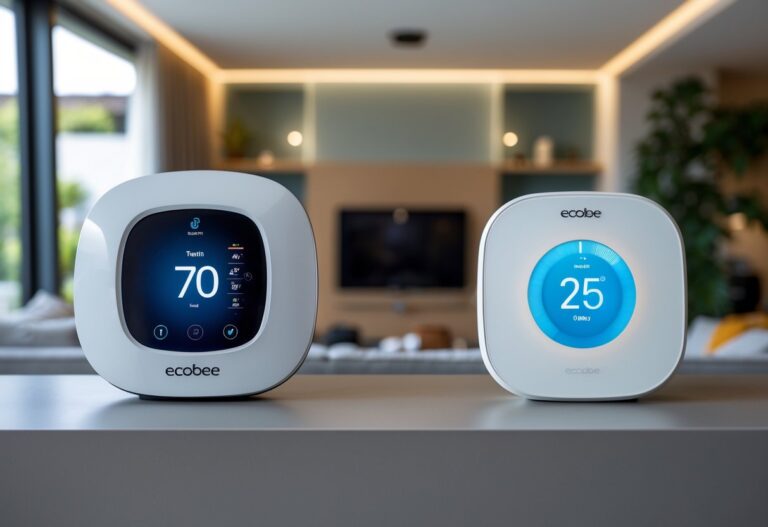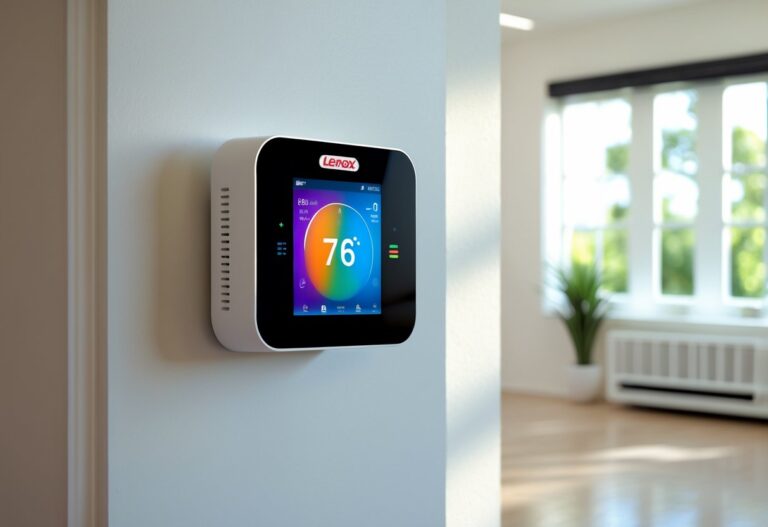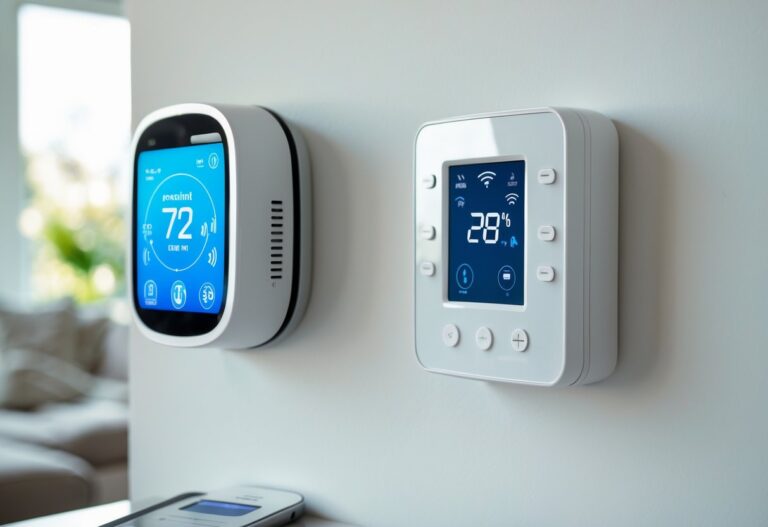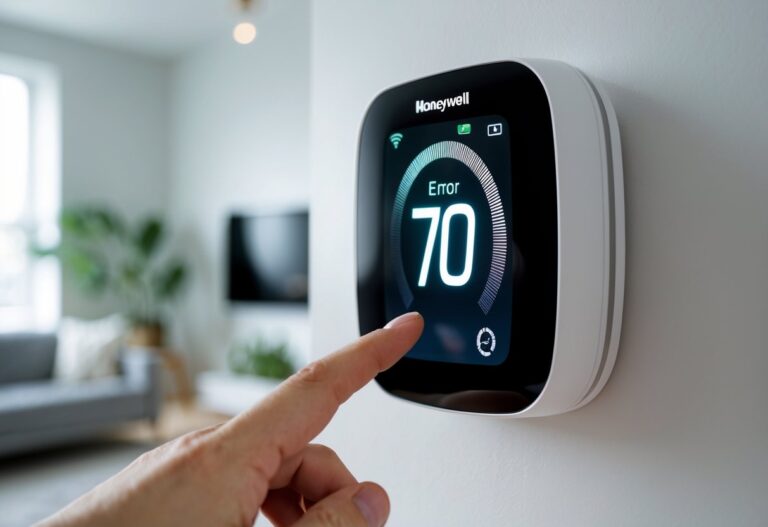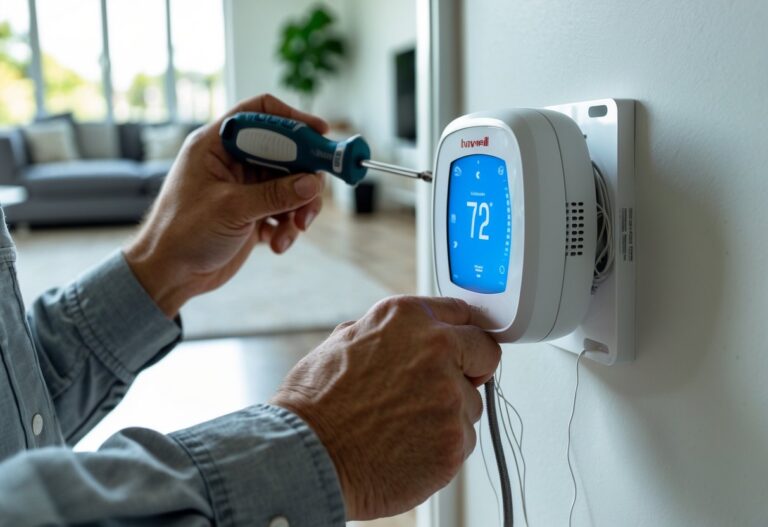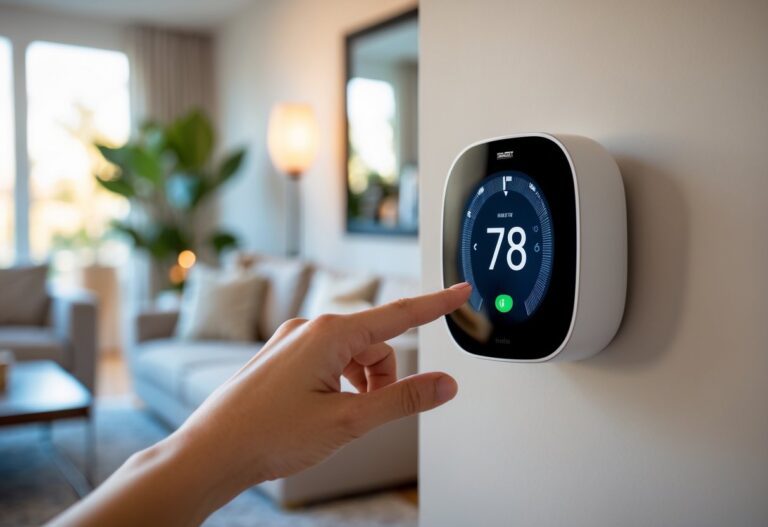Are you thinking about upgrading your home’s heating and cooling with a smart thermostat? These devices offer simple controls, energy savings, and can connect right into your smart home. Smart thermostats are usually installed by licensed HVAC professionals, but some electricians and handy homeowners also handle the job.
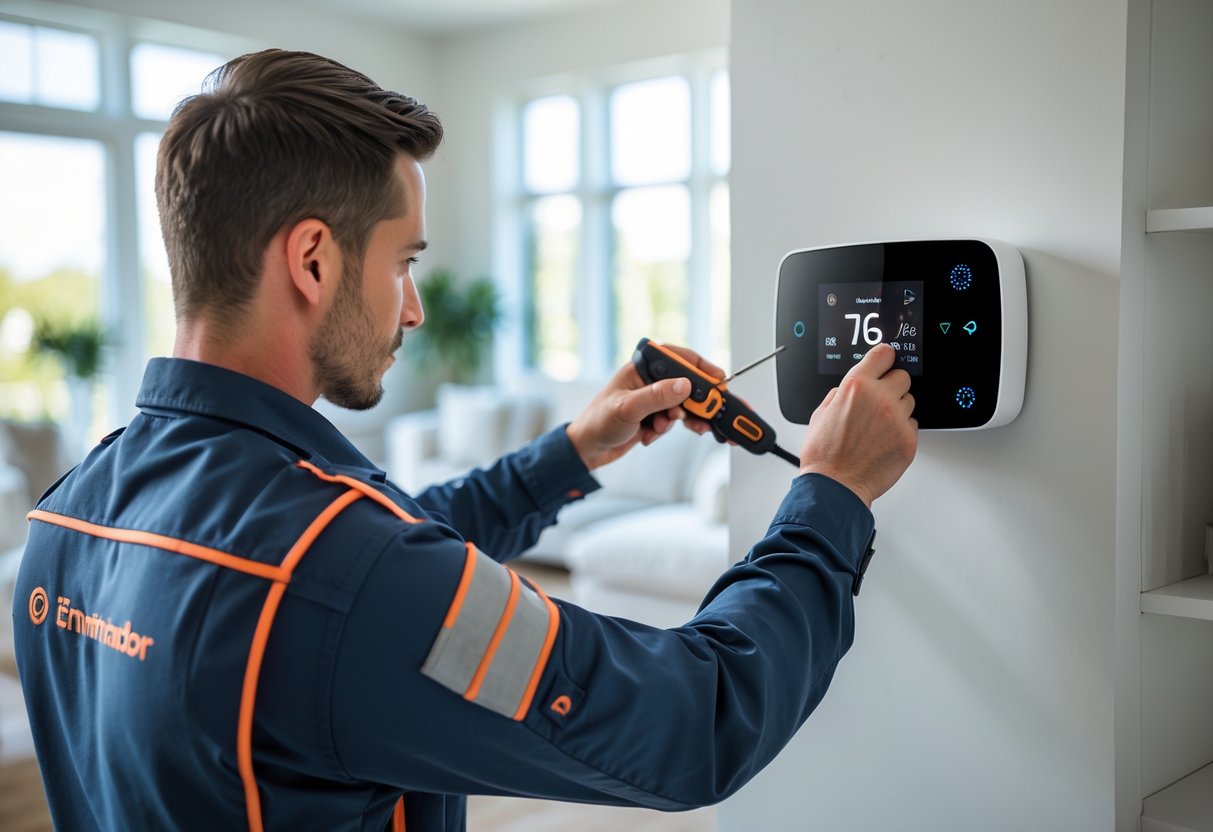
Proper installation makes sure your thermostat works well with your air conditioning or heating system. You’ll want to know if the process is best left to an expert or if you can do it yourself. Smart thermostats have many features and every home setup is a little different, so it’s important to know your options.
Key Takeaways
- HVAC professionals most often install smart thermostats.
- Some smart thermostats can be installed by electricians or homeowners.
- Choosing the right installer helps you get the best performance and energy savings.
Who Installs Smart Thermostats
Smart thermostat installation can be done by several types of professionals or by homeowners themselves. Your best choice depends on your home’s HVAC system, your comfort with electrical work, and your preferences for convenience.
Professional HVAC Technicians
HVAC technicians are experts in heating, ventilation, and air conditioning systems. They can check that your smart thermostat is compatible with your current HVAC setup. This is important because some systems require special wiring or compatibility checks.
Technicians will handle every part of the installation, including managing any wiring or system upgrades needed. They also make sure the thermostat settings work well with your HVAC system for efficient heating and cooling.
Most HVAC companies offer installation as a service. Some can also give advice on choosing the right smart thermostat for your needs. Hiring a professional is useful if your system is complex or you have questions about zoning, wiring, or advanced features.
Electricians
Electricians are qualified to handle all types of electrical installations. If your smart thermostat requires new wiring, a C-wire, or any electrical adjustments, they are well equipped to do the job safely.
Some homeowners call electricians if they are unsure about home wiring or have power concerns. This is especially true in older homes, where electrical systems may not match modern thermostats.
Electricians may not be able to troubleshoot your HVAC system like an HVAC technician would. However, for basic installations or electrical upgrades related to your thermostat, their skills are valuable and can give you peace of mind.
Certified Smart Home Installers
Certified smart home installers, sometimes found through big box stores or online services, specialize in connecting devices like smart thermostats. They help with setup, Wi-Fi connection, and app integration.
These professionals usually follow manufacturer guidelines and make sure your smart thermostat works with other home automation products. You can often book installation as part of your purchase when buying at stores like Best Buy or Home Depot.
Key services offered:
- Device compatibility checks
- Installation and setup
- Home network integration
- Basic use training
They are a good choice if your main focus is connecting your thermostat to a larger smart home system.
DIY Homeowners
Many smart thermostats are designed for do-it-yourself installation. If you are comfortable handling small electrical tasks, you can probably install a unit yourself in under an hour.
Manufacturers provide detailed instructions, often with pictures and phone support. Most of the time, you need to connect a few wires, mount the thermostat, and set up Wi-Fi. DIY installation can save money and let you learn about your HVAC system.
However, some systems might need more work, like adding a C-wire. If you are unsure, always follow safety warnings and consider calling a professional. The DIY route is best for simple systems and confident homeowners.
Types of Smart Thermostats
Smart thermostats come in different models and brands. Each offers unique features for controlling your home’s heating and cooling and may work better with certain systems or preferences.
Nest Thermostat and Google Nest Thermostat
The Nest Thermostat and Google Nest Thermostat are popular choices made by Google. Both models work with most HVAC systems and are known for their easy installation and user-friendly interface.
You can control these thermostats with the Google Home app, your phone, or voice commands. They help regulate temperatures efficiently to lower energy consumption. If you qualify, some energy companies offer rebates for using Energy Star–certified models.
The Nest Thermostat learns your schedule over time and adjusts temperatures automatically. This learning function can save you money without sacrificing comfort. Compatibility with other smart home devices makes these thermostats flexible for many homes.
A color display and simple controls make operation straightforward. You do not need a C-wire with some versions, but it helps with consistent power.
Ecobee Smart Thermostat Premium
The Ecobee Smart Thermostat Premium combines advanced features with high energy efficiency. It comes with a built-in voice assistant, so you can control it hands-free.
This model includes a remote sensor for better temperature readings in different rooms. It can even measure humidity and indoor air quality. The touch screen display is clear and easy to navigate.
The Ecobee Premium is Energy Star certified. It supports integration with Apple HomeKit, Amazon Alexa, Google Assistant, and SmartThings, making it a versatile choice.
You may see lower energy bills if you set schedules or let it adjust automatically. Installation may require a C-wire for best performance, but Ecobee includes a Power Extender Kit if you do not have one.
Ecobee Smart Thermostat Enhanced
The Ecobee Smart Thermostat Enhanced shares many benefits with the Premium version but at a lower price. It’s designed to be simple while still offering strong energy efficiency.
Key features include easy scheduling, smart home integration, and motion detection to know when you are home. This model uses a smaller display and does not include all of the advanced sensors found in the Premium version.
You still get Energy Star certification and clear instructions for installation. Voice control works through integrations instead of being built-in, but most users find this enough for daily needs.
Remote sensors are supported but usually sold separately. Installation may be easier if you already have a C-wire, and the Ecobee app guides you step by step.
Amazon Smart Thermostat
The Amazon Smart Thermostat is an affordable option designed for people who want to upgrade to a smart system without a high cost. It works with most 24V HVAC systems.
You can control it with the Alexa app and by voice if you have an Echo device. While simple, it offers the main features you need, like scheduling, away modes, and reports on energy use.
This thermostat is Energy Star certified, helping you lower heating and cooling bills. It does not have a built-in speaker for Alexa, so you need a separate Alexa device for voice control.
A C-wire may be needed for installation, but an adapter is available. The clear display and basic controls make it user-friendly even for first-time smart thermostat owners.
Benefits of Professional Installation
Hiring a professional to install your smart thermostat can help you avoid connection issues, set up advanced features, and make sure your system runs at its best. A skilled installer can also handle electrical requirements like the c-wire and help you get the most savings and comfort.
Ensuring Proper Connectivity and Compatibility
A professional checks if your home’s HVAC system supports a smart thermostat. Many smart thermostats need a common wire, or c-wire, for constant power. Not all older systems have a c-wire. An installer can add one if needed, preventing power issues and connectivity drops.
Wiring mistakes can damage your HVAC equipment or cause the thermostat to not work as intended. Technicians follow safety procedures and wiring diagrams to make sure connections are done correctly. This step protects your equipment and often keeps your warranty valid.
Some smart thermostats work better with certain HVAC units, heat pumps, or multi-stage systems. A professional knows how to check compatibility and adjust the wiring and settings for your model. This avoids errors and ensures your thermostat functions as designed.
Maximizing Energy Efficiency
One of the main reasons people choose a smart thermostat is to save energy and lower costs. Professionals can set up schedules and temperature zones during installation. They know how to sync sensors in different rooms for even heating and cooling.
Installers also check that your thermostat runs software updates and that energy-saving modes are active. If your smart thermostat needs special setup for features like adaptive learning or geofencing, a pro can enable these during installation.
Proper installation avoids wasted energy caused by wrong wiring or poor sensor placement. Installers can explain how to use reports and energy charts for better control. Their help makes your system more efficient from day one.
Optimizing Voice Control Features
Many smart thermostats offer voice control with devices like Amazon Alexa, Google Assistant, or Apple HomeKit. Professionals connect your thermostat to your home Wi-Fi and set up these integrations. This lets you control temperature using simple voice commands.
If your system uses multiple smart devices, a technician can organize settings in your app or smart home dashboard. This makes it easier to adjust your thermostat through your phone or with voice commands.
Installers test voice control after setup to confirm that commands work as expected. They can also fix any issues connecting to your smart speaker and help you learn key commands for changing temperature or modes. This helps you use voice control smoothly every day.
DIY Smart Thermostat Installation Considerations
Installing a smart thermostat yourself can help you save money and give you more control over your home’s heating and cooling. However, you need to be aware of system requirements, specific wiring, and details unique to Wi-Fi thermostats to avoid installation issues.
Checking HVAC System Compatibility
Before you start, you need to check if your current HVAC system can work with the smart thermostat you want. Not every thermostat fits every system. Some older heating and cooling setups aren’t compatible with modern, Wi-Fi thermostats.
Look for compatibility lists on the manufacturer’s website. Many Energy Star® certified models have guides that help you match your system. You may need to find your system’s make and model, or even contact customer support for help.
Make note of your system type—forced air, heat pump, or radiant, for example. Write down any details like voltage or control board types, as those can affect compatibility. Knowing your system details upfront will prevent wasted time and frustration.
Dealing with C-Wire Requirements
Most smart thermostats, especially Wi-Fi models, need a constant power supply called a C-wire (common wire). This wire helps keep the thermostat always on and connected to your network. Without it, some features may not work.
Take off your old thermostat faceplate and inspect the wiring. You should see terminal labels such as R, W, Y, G, and possibly C. If the C-wire is missing, some brands offer power adapters, or you might need a professional to install one.
A table can help you identify wiring:
| Terminal Label | Wire Function |
|---|---|
| R | Power (Red) |
| W | Heat (White) |
| Y | Cool (Yellow) |
| G | Fan (Green) |
| C | Common (Blue/Black) |
Make sure to turn off the power before handling any wires. Double check your wiring before you begin installation.
Following Manufacturer Instructions
Carefully read the instructions from your thermostat’s manufacturer. Each model—whether it’s Energy Star® certified or basic—can have different steps. Many include helpful guides, videos, or even phone support.
Follow every step, especially when connecting wires and securing the device to the wall. Use the provided labels or stickers to keep track of which wire goes where. Missing a step can keep your new smart thermostat from working right.
If your thermostat has extra features, like learning settings or voice control, set those up as the directions suggest. Connecting to Wi-Fi is key for smart features, so keep your network name and password ready.
Troubleshooting Common Issues
Problems can happen even if you follow the instructions. The most frequent issue is the thermostat not getting power, often because of a missing or wrongly connected C-wire. Double check connections and that your HVAC breaker is on.
Wi-Fi problems are common too. Make sure your router is close enough and the network supports the device. Sometimes, you need to reboot your new thermostat or your router during setup.
If the heating or cooling does not turn on, check the wiring again. Thermostat apps or the support website might have troubleshooting tips. Some newer thermostats include a help tool or support chat within the app for quick answers. If nothing works, reach out to the manufacturer’s support line or consider hiring a pro.
Integrating Smart Thermostats With Smart Home Systems
Smart thermostats often work smoothly with major smart home platforms. This allows you to manage heating and cooling using voice commands, automation, and smartphone apps.
Amazon Alexa Integration
Many smart thermostats, such as Honeywell, Ecobee, and Sensi, are compatible with Amazon Alexa. Once connected, you can control the temperature in your home by speaking to any Alexa-enabled device. For example, you might say, “Alexa, set the living room to 72 degrees.”
Alexa can help you create routines. This means you can program actions like lowering the heat when you say, “Goodnight,” or raising it when you arrive home.
You can also check the current thermostat settings or ask for the temperature in certain rooms using voice control. The Alexa app guides you through linking your thermostat and setting up your preferences.
Google Assistant and Google Home
If you use Google Home or Google Assistant, smart thermostats can be easily managed by voice or through the Google Home app. Supported brands, including Honeywell and Ecobee, offer smooth integration, letting you change temperatures, set schedules, or even turn the system off with a simple phrase.
You can say commands like, “Hey Google, turn up the heat,” or “Set the thermostat to 68 degrees.” Google’s routines feature lets you tie thermostat changes to specific events, like leaving the house or waking up.
Using the app, you’ll have remote access to your HVAC system and can see usage reports. Integration may also allow you to set preferred temperatures in specific zones if your system supports this.
Apple HomeKit Compatibility
Apple HomeKit compatibility is available on select smart thermostats, like some Ecobee models. You can use the Home app on iPhones, iPads, or Macs to view and change your home’s temperature from anywhere. You can use Siri voice control to set a specific temperature or check the current indoor climate.
HomeKit supports automation, so your smart thermostat can adjust automatically when you arrive home or when a sensor detects you’re in a certain room. You can also set up scenes, such as “Bedtime,” to change multiple settings at once.
Security features are built in with HomeKit, so your device controls require authentication for added privacy. This can give you peace of mind when managing your home’s heating and cooling remotely.
Key Features Offered By Smart Thermostats
Smart thermostats provide modern ways to control your home’s temperature. They can reduce your energy use and make it easier to manage comfort from anywhere.
Wi-Fi Connectivity
Most smart thermostats are Wi-Fi enabled. This lets you control the temperature from your phone, tablet, or computer. As long as your device is connected to the internet, you can check or change your settings.
Wi-Fi connectivity also allows for software updates and new features without replacing the device. Some thermostats send you maintenance alerts or tell you when to change filters. These notifications help keep your HVAC system running well.
Wi-Fi thermostats often track your energy use and show reports. You can see how much energy you are using, which helps you make choices to save money.
Flexible Scheduling and Automation
Flexible scheduling lets you set different temperatures for different times of the day or week. For example, you can keep it cooler at night and warmer in the morning. This helps lower your energy bills when no one is at home.
Many smart thermostats use automation to learn your routine. They can figure out when you usually leave the house or return and change the temperature for you. This means you do not have to change settings every day.
You can make custom schedules for weekends or holidays. Some thermostats use a simple table or timeline to set your plan, making it easy to see and adjust.
Geofencing and Remote Access
Geofencing uses your phone’s location to know if you are home or away. When you leave a set zone around your home, the thermostat can switch to an energy-saving mode. When you get close to home again, it prepares your house for your arrival.
With remote access, you can adjust your device from anywhere, even if you are at work or on vacation. If your plans change, you can update the temperature right from your phone.
This combination of geofencing and remote control makes it simple to save energy without sacrificing comfort. It also helps avoid wasting energy when no one is at home.
Energy Efficiency and Savings Potential
Smart thermostats can help you manage your home’s temperature while using less energy. These devices can automatically adjust settings to save power, which lowers heating and cooling bills and reduces your energy usage.
Reducing Heating and Cooling Bills
Smart thermostats are designed to cut waste from heating and cooling systems. By learning your schedule and adjusting temperatures only when needed, they help you lower your utility bills.
For many homes, heating and cooling make up the largest portion of energy expenses. With features like automatic adjustments, remote control from your phone, and even suggestions for small changes, a smart thermostat can make your system more efficient.
According to energy experts, these thermostats have the potential to save you up to 10% on heating and cooling costs each year. For larger homes or homes with older HVAC systems, the savings can be even greater.
Understanding Energy Costs
The cost of heating and cooling your home depends on many factors. These include the weather in your area, the efficiency of your HVAC system, and how often you run it.
A smart thermostat helps you track and understand your energy use. Most models offer easy-to-read charts or reports that show you when you’re using the most energy.
This information allows you to find patterns and change habits. For example, setting your system to use less energy when no one is home can make a big difference on your monthly bill.
Energy Star Certification Explained
Many smart thermostats come with an ENERGY STAR label. This certification means that the product meets strict energy efficiency guidelines set by the U.S. Environmental Protection Agency.
To earn this label, a smart thermostat must show proof of real energy savings. ENERGY STAR-certified devices use advanced algorithms to help you save energy without sacrificing comfort.
Choosing a model with this certification gives you extra confidence that your thermostat is designed to reduce your energy costs and help the environment at the same time.
Leading Brands And Models
Smart thermostats come from a few well-known brands, each offering unique features, price points, and smart home compatibility. Choosing the right model can impact comfort, energy savings, and how easily your system integrates with other devices.
Resideo
Resideo is the company behind Honeywell Home thermostats. Their smart thermostats are popular for their reliability and compatibility with most heating and cooling systems. Many models, like the Honeywell Home T9 and T10 Pro, feature remote room sensors.
Key features often include:
- Geofencing so your home is comfortable when you arrive.
- Touchscreen controls for easy adjustments.
- Compatibility with Alexa, Google Assistant, and Apple HomeKit.
The company provides strong support for both professional and DIY installation. Resideo is also known for straightforward programming and reliable app performance.
Google Nest
Google Nest thermostats are well-known for their learning capabilities. The Google Nest Learning Thermostat tracks your routines and sets temperatures to help you save energy.
Some main features:
- Auto-Schedule creates a custom routine for you.
- Energy History shows how much energy you use.
- Voice control works with Google Assistant and Alexa.
Nest models are easy to install and set up for most people. They work with a wide variety of systems and often help lower energy bills. Their clean, round design is simple and fits into modern homes.
Ecobee
Ecobee is known for strong temperature control and smart features. The Ecobee Smart Thermostat Premium stands out for its quality, offering a glass finish, radar occupancy sensing, and built-in voice assistant.
You can also consider the Ecobee Smart Thermostat Enhanced, which has a simpler feature set at a lower price. Ecobee devices support remote sensors to help balance comfort across rooms.
Features:
- Alexa voice control built-in.
- Air quality monitoring (Premium model only).
- Integration with Apple HomeKit, Google Assistant, and SmartThings.
Ecobee thermostats are recommended by many experts for consistent performance, energy savings, and reliable customer support.
Frequently Asked Questions
Smart thermostat installation often involves costs for both the device and labor. You may need a qualified electrician, a specialist, or professional installation depending on your home’s wiring and the thermostat model.
What is the average cost to have a smart thermostat installed?
The average cost for professional installation is usually between $100 and $300. This price depends on the complexity of the job and your home’s current wiring. The thermostat itself is often sold separately and can range from $100 to $250.
Can any electrician install a smart thermostat, or does it require a specialist?
Most licensed electricians are qualified to install a smart thermostat. Some installations, especially those that are more complex, may benefit from a heating, ventilation, and air conditioning (HVAC) technician who is familiar with both wiring and HVAC systems.
Which retailers offer installation services for smart thermostats?
Major stores like Best Buy offer installation services for smart thermostats. Other retailers, such as Home Depot and Lowe’s, often have partnerships with local professionals to provide installation.
How do I find a reputable technician to install a smart thermostat in my home?
You can ask for recommendations from friends or family. Reading reviews online and checking with local home service websites can help you find reputable technicians. Make sure to compare options before hiring.
Are there any specific qualifications or certifications I should look for in a smart thermostat installer?
Look for technicians who are licensed electricians or certified HVAC professionals. Some may have additional manufacturer certifications for certain smart thermostat brands. These credentials ensure that the installer understands both electrical systems and HVAC requirements.
Is it possible to self-install a smart thermostat, or is professional installation recommended?
Many smart thermostats are designed for do-it-yourself installation and come with step-by-step guides. If your system has a “C-wire” and standard wiring, you may be able to handle it yourself. If you are unsure about wiring or your thermostat is more advanced, professional installation is recommended.
